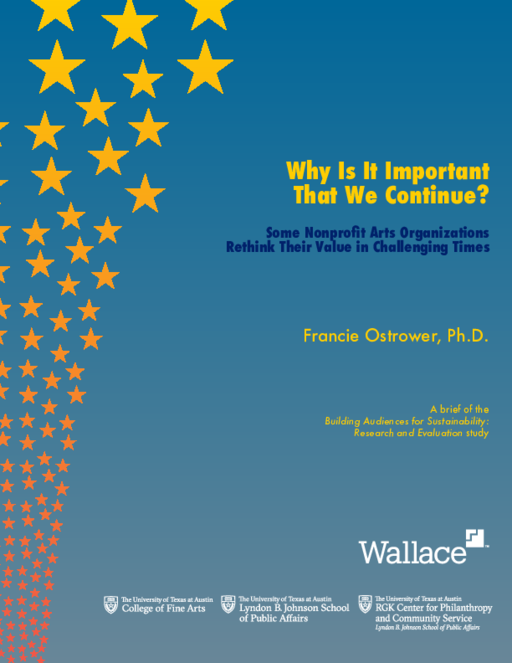Breadcrumb
- Wallace
- Reports
- Why Is It Important That We Cont...
Why Is It Important That We Continue?
Some Nonprofit Arts Organizations Rethink Their Value in Challenging Times

- Author(s)
- Francie Ostrower, Ph.D.
- Publisher(s)
- The University of Texas at Austin
Summary
How we did this
This brief is based on an initial round of personal interviews with leaders and staff at the 25 participating BAS organizations, conducted in late 2015 to 2016. These interviews were conducted by Francie Ostrower and her team at the University of Texas in Austin.
Even before the pandemic, some U.S. nonprofit arts organizations were rethinking their value and relationship with the community. From 2015 to 2019, the Wallace Foundation awarded nearly $41 million in grants to 25 nonprofit performing arts organizations as part of its Building Audiences for Sustainability initiative. The goal of BAS was to engage new audiences while retaining existing ones. The initiative also sought to understand whether audience-building efforts contributed to organizations’ financial health.
Grantees were well-established, relatively affluent institutions with predominantly white leadership. The average organization age was 67 years. All had budgets of over $1 million, and half had budgets in excess of $10 million. Participants included theaters, opera companies, symphony orchestras, dance companies, and performing arts presenters.
This brief captures BAS leaders’ thoughts on nonprofit arts sustainability before the pandemic shuttered arts venues, and the movement for racial justice demanded greater representation and inclusion. It provides a useful pre-Covid benchmark for how thinking in the sector is evolving.
Arts researcher Francie Ostrower and her team at the University of Texas in Austin asked leaders of participating BAS organizations why it was important that their organizations continue. All cited artistic quality and cultural contributions as central to the value they offer. All felt it was important that their organizations continue.
Yet about 40 percent acknowledged that organizations needed to change to remain relevant. Leaders spoke of the importance of community engagement. They spoke of building relationships and the desire to be part of the community fabric. And they spoke of the importance of engaging the community outside of formal venues, in libraries and nursing homes and schools. All of these strategies represent fundamental shifts in thinking and operations that go beyond a set of isolated activities.
It is important to note that these perspectives are specific to a subset of larger, more established institutions. This group has enjoyed considerable advantages but faces considerable pressure to be more representative and inclusive. The brief concludes by asking arts organizations: For reasons of survival and/or values, do you need to change what you do and how you define yourself? And are you ready to do so?

For reasons of survival and/or values, do you need to change what you do and how you define yourself? And are you ready to do so?
Key Takeaways
- Forty percent of BAS organizations acknowledged that significant changes were needed for their organization to maintain relevance
- Rethinking organizational value to encompass a more community-oriented approach goes beyond deploying an isolated set of activities. It intersects with how an organization thinks about itself and who it serves
- Robust community engagement may require overcoming traditional hierarchies in which programs and participants are viewed as secondary or utilitarian
- Leadership endorsement is key to initiating and/or supporting community-oriented engagement
What We Don't Know
This study was conducted with 25 large and well-established nonprofit arts organizations. How do these lessons apply for smaller, less well-established arts organizations?





